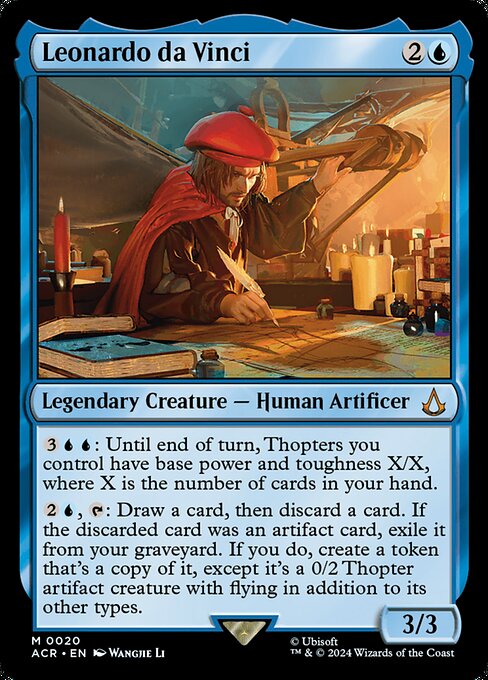
Image courtesy of Scryfall.com
Renaissance Mechanisms: Leonardo as a Template for Fan Card Design
In the magic-movie mashup that is MTG’s design culture, fan cards flourish whenever a real-world figure meets a clever mechanical premise. The legendary card Leonardo da Vinci bursts onto the battlefield as a Legendary Creature — Human Artificer, a bridge between the Renaissance workshop and the blue-red-dominated future of Thopters. This is more than a pretty art piece; it’s a case study in how lore can harmonize with mechanics to spark new design ideas for fan creations—and for Wizards’ own Universes Beyond collaborations. 🧙🔥💎
From the moment you glimpse the card, you’re invited to imagine a genius who sketches first, then builds—who treats ideas as artifacts waiting to be animated. The set name Assassin's Creed anchors a narrative vein: the modern world is stitched to the past, and Leonardo embodies that bridge. The color choice is blue, the color of intellect, control, and clever sequencing; the mana cost is economical enough to see play in aggressive or midrange shells that love card draw, artifact synergy, and tempo. The payoff is a very MTG flavor of “inventor in the workshop” that fans can feel in both flavor text and play patterns. ⚔️🎨
From lore to play: the flavor of a legendary artificer
Leonardo’s card text is a compact manifesto about inventive play. The primary mode is a quickactivation: {3}{U}{U}: Until end of turn, Thopters you control have base power and toughness X/X, where X is the number of cards in your hand. It’s a direct nod to Leonardo’s habit of turning abstract sketches into functional gadgets—the more ideas you’re juggling, the mightier your mechanized swarm becomes. The second line, {2}{U}, {T}: Draw a card, then discard a card. If the discarded card was an artifact card, exile it from your graveyard. If you do, create a token that’s a copy of it, except it’s a 0/2 Thopter artifact creature with flying, is a layered engine: draw to fuel your hand, discard to fuel artifact recursion, and then breathe life into those artifacts as flying copies. It’s both a self-contained draw-then-reassemble mechanic and a token generation engine, a rarity-spark for fan designers to riff on. The synergy between “hand size” and “artifact-copy tokens” feels like a modern echo of Leonardo’s notebooks—where every page held a potential machine. 🧠✨
“When you sketch the future, you should always invite your obstacles to the workshop—hand size, cards in graveyards, and a craving for artifacts are the raw materials.”
Design principles for fan cards inspired by Leonardo
- Flavor as fuel: Tie the character to a tactile, mechanical theme. Leonardo fits blue’s fascination with planning and invention, so let the mechanic reward thoughtful play rather than brute force.
- Resource-based power: Use a tangible resource (hand size) to scale the effect. It creates a natural tension: draw more cards, but manage your resources to keep the bonus meaningful.
- Artifact-centric recursion: The discard-and-exile-to-copy mechanic adds a risk-reward loop. Fan designs can explore alternative reward paths for artifacts, including different creature types, different token stats, or alternate cost structures.
- Token synergy: Tokens aren’t just copies; they become a dynamic army with flying and a distinct identity (the 0/2 Thopter). This invites creative deck-building around artifact ecosystems and graveyard interactions.
- Art and identity: The visual presentation should echo Leonardo’s workshop—dial-like instrumentation, sketches, and metallic palettes—so that the card’s story is readable in both text and illustration.
Playable design implications: how this shape-shifts in formats
In terms of playability, the card is legal in Modern and Legacy, with Commander and Vintage options on the table. The blue strategy emphasizes tempo and value through draw steps and artifact interactions. For fan designers, Leonardo demonstrates a roadmap: craft a compact, flexible ability that scales with a player’s resource pool; pair it with a secondary ability that creates recurrent value through artifacts. The result is a design that rewards careful sequencing (draw first, then use the artifact to fuel a token engine) and invites synergies with other artifact-matters cards. It’s a blueprint for how to balance risk and reward in a fan card: you want the payoff to feel earned, not handed to you on a silver spoon. 🎲⚡
For players, the card rewards a thoughtful build around artifact generation and graveyard exploitation. With the second ability, you can pivot from mere card advantage to artifact replication, spawning a small army of Thopters that can outrun a complacent opponent. The first ability, meanwhile, scales with your planning—your options grow as your hand grows, echoing the Renaissance mindset of maximized potential from limited resources. This is the kind of design that fuels lively discussions in MTG communities about how to balance power with flavor, and how to weave real-world genius into the fabric of a fantasy game. 🧙🔥💎
Art, lore, and collector culture
The illustration by Wangjie Li captures a Renaissance workshop mood, yet it sits in a modern mechanics package. That tension—old-world artistry with new-world gameplay—defines fan-card culture: it’s a tactile way to celebrate memory, invention, and the thrill of discovery. Collectors might appreciate the card’s Mythic rarity, its foil option, and its role in Universes Beyond crossovers. For fans who love to tune decks around artifact synergy, Leonardo serves as a muse for future card concepts that honor history while leaning into clever, modern interactions. And for those who enjoy tracking value, the card’s positioning in the Assassin’s Creed set and its upfront collectible appeal offer a flavorful entry point into deeper discussions about set design and cross-promotional strategy. 🧭🎨
As fan-card design continues to evolve, Leonardo’s example invites us to think bigger about how history, invention, and fantasy can collide on the battlefield. The result isn’t just a playable card; it’s a bridge between eras, a little spark of nostalgia, and a nudge toward more inventive collaborations that respect both the lore and the math of MTG. 🧙♂️⚙️